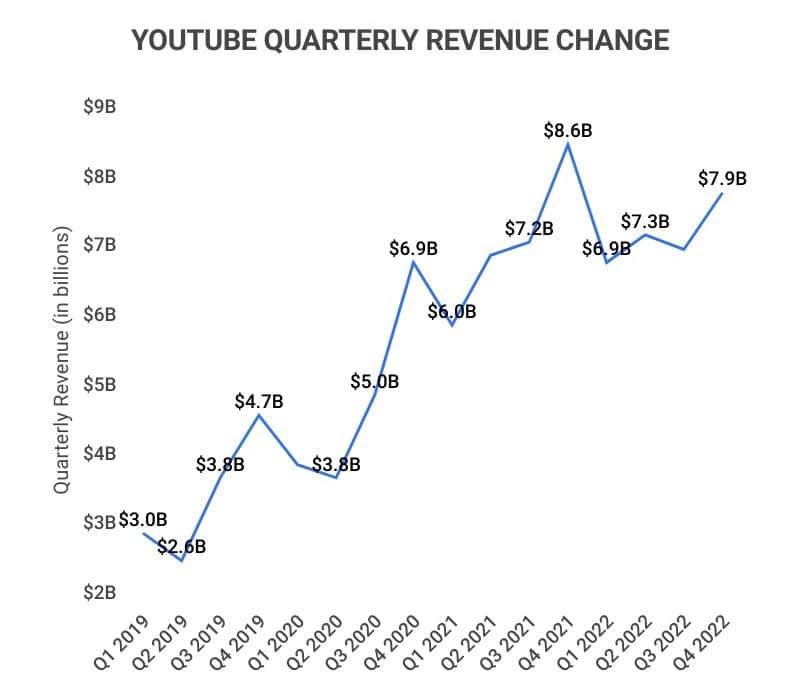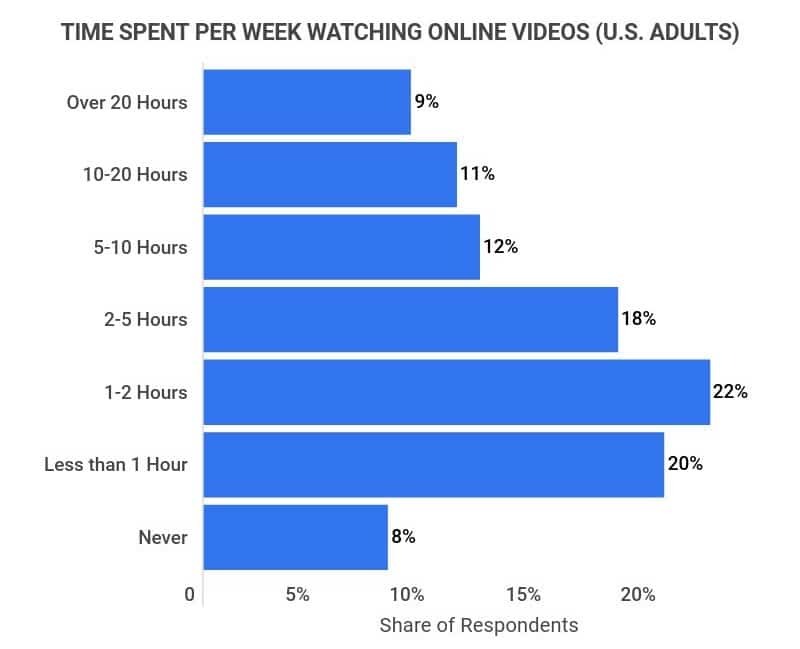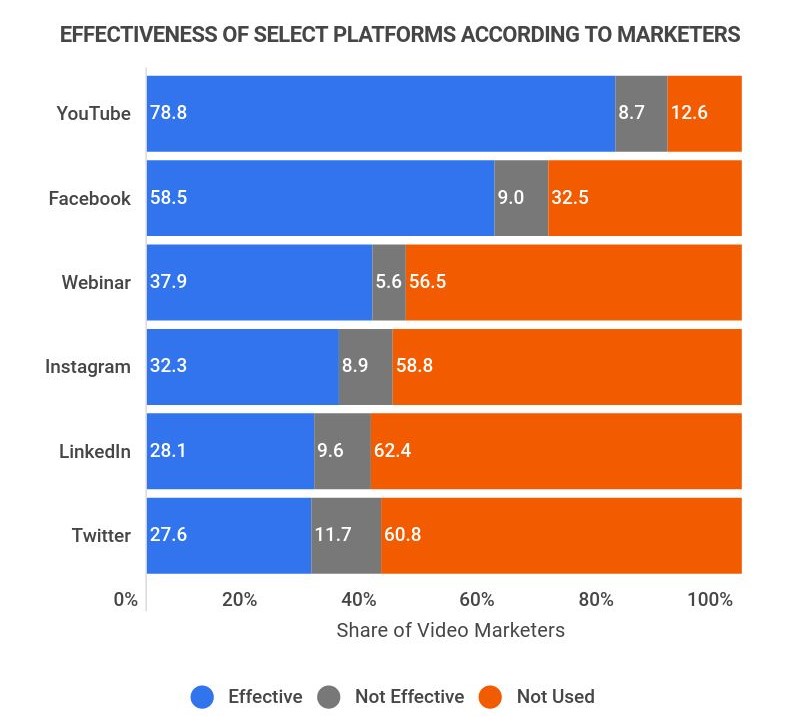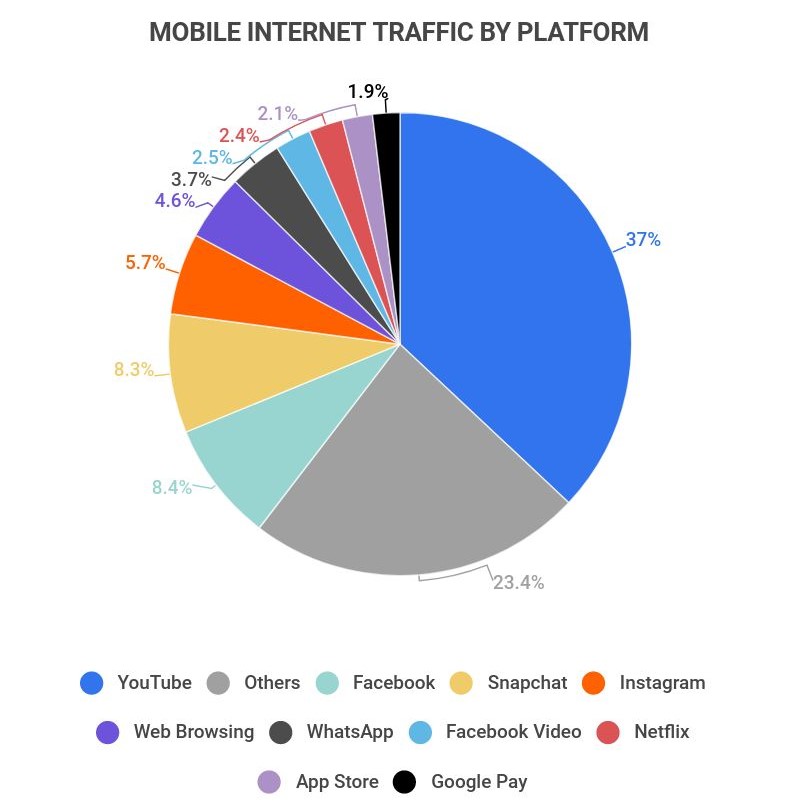Research Summary. From child entertainment to niche video essays, YouTube truly has it all. However, it wasn’t always like this. Over the years, this video-sharing website has grown to be the content monolith it is today. Further, this growth has affected the way we entertain ourselves, as well as the lives of successful YouTubers. According to our extensive research:
-
YouTube has over 2.51 billion monthly active users in 2023.
-
YouTube also has 122 million daily active users.
-
Over 500 hours of video are uploaded to YouTube every minute.
-
Global YouTube watch time now tops 250 million hours every single day.
-
Roughly 5 billion videos are watched on YouTube every day.
-
There are over 51 million YouTube Channels.
For further analysis, we broke down the data in the following ways:
User Behavior | Channels | Advertising | Mobile Traffic | Demographics | Trends | Business Adoption

General YouTube Statistics
Most Americans have used or at least heard of YouTube, but the platform is also a global force. When it comes to the general state of YouTube, here are the facts:
-
YouTube is the #2 website by traffic in the U.S.
With over 4.11 billion visits in December 2021, YouTube is the second most trafficked website in the U.S. The only website that beats YouTube is Google (15.63 billion), with the third, fourth, and fifth most trafficked sites being Facebook (3.36 billion), Amazon (2.69 billion), and Yahoo (1.5 billion).
-
81% of global internet users have watched YouTube.
And of all internet users, 79% also have their own YouTube account. That means the vast majority of YouTube users have their own account, with only 2% watching videos without one.
-
43% of global YouTube users access the site every month.
And that percentage is much higher in the U.S., as a whopping 98% of American YouTube users access the site once a month or more.

YouTube Statistics by User Behavior
YouTube is driven by user behavior, as without a thorough understanding of it, the platform wouldn’t be nearly as successful as it is. With that in mind, here are some interesting facts about YouTube user behavior:
-
YouTube has up to 122 million daily visitors.
-
62% of American internet users access YouTube daily, while 85% access YouTube at least once per week.
-
The average YouTube visitor spends at least 40 minutes on the site.
-
51% of youtube viewers say they rely on YouTube videos to learn to do something new.
-
90% of consumers discover new brands or products through YouTube.
-
YouTube’s algorithm is highly effective, with 70% of the content people choose to watch being recommended to them by YouTube.
-
40% of U.S. adults spend 1-5 hours per week watching YouTube videos.

YouTube Statistics by Channels
In large part, YouTube is successful due to the sheer abundance of content on the site. Without the massive quantity of channels that provide endless hours of niche entertainment, people wouldn’t be as drawn to the content. Knowing that, here are some interesting facts about YouTube’s many channels:
-
There are over 51 million YouTube channels.
A number that grew by 36% since 2021. However, it’s also worth noting that only 29,000 YouTube channels have over 1 million subscribers. While on the contrary, 17 million channels only have subscribers. In truth, most YouTube channels don’t post any content at all.
-
YouTube has roughly 15 million active content creators.
And with an average of 500 hours of content uploaded to the site every minute, that means these creators are highly active. In fact, the average YouTuber posts at least one video per week or more.
-
T-Series is the largest YouTube channel, with 238 million subscribers.
T-Series is an Indian music record label and film production company that dethroned PewDiePie as the largest YouTube channel in 2019. As of 2023, Cocomelon is the second-largest YouTube channel, with 155 million subscribers, followed by SET India (153 million), MrBeast (137 million), and PewDiePie (111 million).
Channel Number of Subscribers (2023) T-Series 238M Cocomelon 155M SET India 153M MrBeast 137M PewDiePie 111M Kids Diana Show 109M Like Nastya 105M Vlad and Niki 94.9M WWE 93.8M Zee Music Company 93.4M -
Just 10% of popular YouTube channels with over 250,000 subscribers are responsible for 70% of all videos posted.
On YouTube, a few successful and consistent channels dominate the platform. In fact, the videos posted by that same 10% of large channels also receive an average of 79% of all views.
-
People and Blogs are the most popular YouTube video category, making up 32% of the videos posted on the site.
This includes popular genres like vlogging or commentary channels. Meanwhile, the second most popular video category is Gaming (31%), followed by Entertainment (10%), Film and Animation (6%), and Music (5%).
YouTube Statistics by YouTube Advertising
YouTube and its content creators also wouldn’t be successful without advertising. After all, advertising is what allows YouTube channels to make an income off their videos. According to our research:
-
70% of YouTube viewers have bought a brand after seeing it on YouTube.
Videos are already highly effective forms of advertising, but many ads on YouTube take this a step further. Whether the brand is advertised before a video, being sponsored by a YouTuber, or being advertised in a full-length video of its own, YouTube makes it easy for that brand to get its name out there.
-
68% of YouTube users watched videos on the site to help make a purchase decision.
In fact, between 2016 and 2018 alone, watch time for shopping-related videos grew more than 5X in the U.S. Overall, “shop with me,” shopping sprees and other shopping-related videos are becoming increasingly more common. This, in turn, affects consumer decision-making.
-
At least 51% of B2B and B2B marketers run ads on YouTube.
YouTube is a popular choice for marketers because the platform centers around video. For instance, 89% of marketers say video gives them a good ROI, and 83% also say videos help them with lead generation.
-
78.8% of video marketers believe YouTube is an effective platform for marketing.
When it comes to video marketing, YouTube beats out any other platform. For instance, only 58.5% of marketers said the same about Facebook, followed by Webinars (37.9%), Instagram (32.3%), and LinkedIn (28.1%).

-
Video ads on YouTube generate up to 80% more ad recall.
If you remember that unsettling GrubHub ad with the loud music and overly stretchy characters, you’re not alone. In fact, companies who choose to create video ad campaigns for YouTube are finding that their ad recall is significantly increased by these videos.
-
In 2021, YouTube’s global ad revenue amounted to $28.84 billion.
Further, this number is even more impressive when considering the fact that it’s a 46% increase from 2020 when revenue was approximately $19.7 billion.
YouTube Statistics by Mobile Traffic
While YouTube has more desktop users than most other Social Media websites, mobile users are becoming increasingly prevalent. Overall, when it comes to mobile YouTube traffic, our research shows that:
-
Roughly 63% of YouTube watch time comes from mobile devices.
-
As of 2022, 40% of YouTube traffic comes from mobile devices, up from only 6% in 2011.
-
YouTube accounts for 37% of all global mobile internet traffic.

-
YouTube receives over 1 billion mobile views per day.
-
At least 75% of Americans choose to watch YouTube on their mobile device at home.
YouTube Statistics by User Demographics
As with all other popular platforms on the internet, YouTube is especially popular with specific demographics. Knowing these demographics can be incredibly useful for marketing and exploring future trends. Overall, here are the facts:
-
YouTube is most popular with those aged 15-25 and 26-35, with 77% of each demographic using the platform.
In fact, YouTube is popular with every age group, with over 60% of people using the platform, regardless of age. More specifically, 73% of those 36-45, 70% of those 46-55, and 67% of those 56+ watch YouTube.

-
Males account for 53.9% of YouTube users.
Men are slightly more likely to use YouTube than women, as YouTube users are divided between 53.9% being male and 46.1% being female.
-
India has the biggest YouTube audience, at 467 million.
Part of the reason Indian YouTube channels are so popular is that there are more Indian viewers than viewers from any other country. For reference, the U.S. has the second-largest audience, but it’s only half that of India at 240 million.
Country Audience Size (in millions) India 467M United States 240M Indonesia 127M Brazil 107M Russia 99M Japan 93.8M Mexico 74.1M Germany 66M Pakistan 55.7M Vietnam 53.2M United Kingdom 53M Turkey 50.6M Philippines 49.6M France 43.1M South Korea 40.5M Egypt 39.3M Italy 37.4M Thailand 37.3M Spain 36.1M Bangladesh 32.2M
YouTube Trends and Projections
YouTube is huge right now and, unlike Myspace, shows no signs of falling into obscurity. Instead, here are some interesting YouTube trends and projections:
-
Between 2019-2022, consumer online video consumption increased by 121%.
-
Between 2011 and 2021, YouTube’s revenue increased 21X (from $1.3 billion to $28.84 billion).
-
From 2012 to 2021, the number of annual YouTube users increased by 225% (from 800 million to 2.6 billion).
-
YouTube is projected to have 2.85 billion users by 2025.
YouTube Statistics by Business Adoption
Because YouTube is highly popular and profitable for marketers, more and more businesses have been adopting it. Here are some interesting insights our team uncovered:
-
62% of businesses post videos on youtube.
Aside from creating ads, many businesses also choose to create full-length videos on their own YouTube channels. These videos are highly effective, leading to up to 84% of viewers choosing to buy from the brand associated with the video.
-
Only 9% of small businesses have adopted YouTube as a marketing platform.
Many small businesses could stand to make YouTube a part of their marketing strategy. After all, one of the most challenging aspects of starting a small business is finding ways to stand out, and YouTube greatly improves SEO results for the small businesses who choose to use it.
YouTube Statistics FAQ
-
There are around 2.51 billion people who use YouTube every month. Overall, YouTube is available in at least 100 countries, and the number of users is spread out amongst them. The top five countries by the number of YouTube users include India (267 million), the United States (240 million), Indonesia (127 million), Brazil (107 million), and Russia (99 million).
-
How many hours of video are uploaded to YouTube every minute?
Over 500 hours of video are uploaded to YouTube every minute. That equates to an astonishing 30,000 hours of freshly uploaded content by the hour. What’s more, is that this number has been growing for a while and continues to grow. Between 2014 and 2020, the number of video content hours uploaded every minute increased by 40%.
-
How many hours of video are watched on YouTube every day?
There are around 250 million hours of videos watched on YouTube every single day. And those hours are spread across roughly 5 billion videos watched every day. Overall, YouTube has much higher retention rates than most other social media sites.
For instance, the average user spends 40 minutes on YouTube, but only 33 minutes on Facebook and 24 minutes on Instagram.
-
How many subscribers does YouTube Premium have?
YouTube Premium now has 50 million subscribers. That’s a 150% increase from 2020 when there were only 20 million subscribers. A poignant example of how YouTube has become even more popular since the start of the COVID-19 Pandemic.
-
Those under the age of 35 watch YouTube the most. Overall, the platform is most popular with those 15-25 and 26-35, with 77% of each demographic using it. However, YouTube is still popular with every age group, with over 60% of people using the platform, regardless of age.
More specifically, 73% of those 36-45, 70% of those 46-55, and 67% of those 56+ watch YouTube.
Conclusion
As the #2 most trafficked website in the U.S., YouTube has come a long way in only ten years. Today, at least 2.51 billion people use the platform to watch 5 billion videos every single day. In fact, YouTube is so dominant in online video sharing and video content creation that 78.8% of video marketers believe YouTube is the most effective platform for marketing.
Overall, YouTube’s growth will almost certainly continue, especially due to trends set by the COVID-19 Pandemic. Between 2019-2022 alone, consumer online video consumption increased by 121%. And by 2025, YouTube’s user base could reach 2.85 billion.
Sources:
-
YouTube Official Blog. “YouTube for Press.” Accessed on April 11th, 2022.
-
Statista. “Hours of video uploaded to YouTube every minute as of February 2020.” Accessed on April 11th, 2022.
-
Think with Google. “Marketing Strategies.” Accessed on April 11th, 2022.
-
Semrush Blog. “Top 100: The Most Visited Websites in the US.” Accessed on April 11th, 2022.
-
Backlinko. “How Many People Use YouTube in 2022? [New Data].” Accessed on April 11th, 2022.
-
BroadbandSearch. “Average Time Spent Daily on Social Media (Latest 2022 Data).” Accessed on April 11th, 2022.
-
The Verge. “Half of YouTube viewers use it to learn how to do things they’ve never done.” Accessed on April 11th, 2022.
-
Tubics. “How Many YouTube Channels Are There?” Accessed on April 11th, 2022.
-
Pew Research Center. “A Week in the Life of Popular YouTube Channels.” Accessed on April 11th, 2022.
-
Statista. “Distribution of total YouTube video content worldwide as of December 2018, by category.” Accessed on April 11th, 2022.
-
Insider Intelligence. “Marketers Think YouTube, Facebook Are Most Effective Video Ad Platforms (Surprise!).” Accessed on April 11th, 2022.
-
YouTube Insights. “Measuring the Impact of Online Video on Brand Metrics.” Accessed on April 11th, 2022.
-
Statista. “Worldwide advertising revenues of YouTube from 2017 to 2021.” Accessed on April 11th, 2022.
-
Statista. “Distribution of worldwide YouTube viewing time as of 2nd quarter 2021, by device.” Accessed on April 11th, 2022.
-
PCWorld. “More than 40 percent of YouTube traffic now comes from mobile.” Accessed on April 11th, 2022.
-
Statista. “YouTube is Responsible for 37% of All Mobile Internet Traffic.” Accessed on April 11th, 2022.
-
Think with Google. “Consumer Insights.” Accessed on April 11th, 2022.
-
Statista. “Percentage of U.S. internet users who use YouTube as of 3rd quarter 2020, by age group.” Accessed on April 11th, 2022.
-
Statista. “Distribution of YouTube users in the United States as of February 2022, by gender.” Accessed on April 11th, 2022.
-
Adweek. “Video Consumption Increased 121% Since 2019, per Wistia’s State of Video Report.” Accessed on April 11th, 2022.
-
Statista. “Forecast of the number of Youtube users in the World from 2017 to 2025.” Accessed on April 11th, 2022.
-
MileIQ. “How to use YouTube for your small business.” Accessed on April 11th, 2022.




